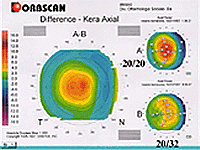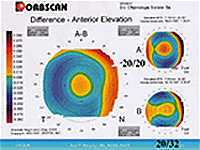Link between topography and laser can target astigmatism
Much of the population has at least 0.5 D of irregular astigmatism. A custom ablation can sharpen postoperative acuity.
HOUSTON — About 39% of the general population has at least 0.5 D of asymmetric bow-tie or irregular astigmatism, and surgeons are looking at topography-guided lasers as a way to fine-tune their visual acuity outcomes.
About one-half of the 39% have asymmetric astigmatism and the other half have irregular astigmatism. Some patients may see 20/25, but they do not see perfectly.
According to Jack T. Holladay, MD, MSEE, “These patients can get a custom ablation that will take that asymmetric bow-tie or irregular astigmatism and turn it into a good looking surface.”
Placido disk topography maps show curvature and power, but they do not reveal what a laser needs to remove from the cornea because curvature is different from height.
“The laser sees that cornea like a bunch of vertical toothpicks, lined up and of different heights,” Dr. Holladay said. “The laser’s job is to shave off the top of those toothpicks in a way that they all end up with the right height and curvature. All the laser can understand is height.”
Good is not enough
Dr. Holladay has worked with a number of systems in an attempt to link topographers and excimers. Since 1997, he has worked with the Orbscan (Bausch & Lomb Surgical, Claremont, U.S.A.) unit in an attempt to guide his excimer procedures.
The Orbscan unit uses slit scanning technology and Placido technology to confirm the height data. Placido disk technology alone does not offer this information and is not as accurate in irregular corneas, he said.
“The slit scan/Placido combined give you height data directly, as well as the values that you need,” he said. “Placido disks alone give you good curvature data, but for height data you need some reference that specifically physically measures the vertex of the cornea.”
Italian research
Since 1997, Dr. Holladay has worked with researchers in Bari, Italy, to link the Orbscan unit with a LaserSight (Winter Park, U.S.A.) flying spot laser.
Those researchers performed 150 consecutive cases with photorefractive keratectomy and laser in situ keratomileusis. Some of the patients had decentered ablations from previous procedures or irregular astigmatism. Although many patients had at least 20/30 vision, the custom ablation improved their vision to as much as 20/10, Dr. Holladay said. At press time, the full results were scheduled to be reported at the 1999 American Academy of Ophthalmology meeting.
Many patients with small optical zones complain of halos or unwanted images at night, and the custom ablation dramatically reduced these side effects, he said.
“The impressive part about that is that the patients who have problems with nighttime glare had their nighttime glare eliminated totally, as well as getting improvements in vision,” Dr. Holladay said.
“When you see someone go from 20/25 to 20/10, well that’s great, but so what? The point was that 20/25 doesn’t have the rest of the story about nighttime glare.”
International clinical trials of this technology will soon commence, according to the company.
“There’s a whole other population of people out there who have had refractive surgery that have had less than desirable outcomes,” Dr. Holladay said. “We’re hooking this up so that it becomes something that becomes automatic with the program.”
|
| 56 y/o female right eye |
|---|---|
| 10/17/97
Source: Jack T. Holladay, MD, MSEE |
For Your Information:
- Jack T. Holladay, MD, MSEE, practices at 2855 Gramercy, Houston, TX 77025 U.S.A.; +(1) 713-668-6828; fax: +(1) 713-669-9153. Dr. Holladay has no direct financial interest in any of the products mentioned in this article. He is a paid consultant for LaserSight and Bausch & Lomb.


